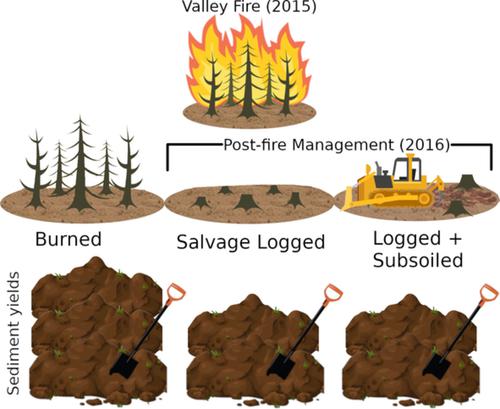当前位置:
X-MOL 学术
›
Hydrol. Process.
›
论文详情
Our official English website, www.x-mol.net, welcomes your feedback! (Note: you will need to create a separate account there.)
Hillslope sediment production after wildfire and post‐fire forest management in northern California
Hydrological Processes ( IF 3.2 ) Pub Date : 2020-10-23 , DOI: 10.1002/hyp.13932 Ryan P. Cole 1 , Kevin D. Bladon 1 , Joseph W. Wagenbrenner 2 , Drew B. R. Coe 3
Hydrological Processes ( IF 3.2 ) Pub Date : 2020-10-23 , DOI: 10.1002/hyp.13932 Ryan P. Cole 1 , Kevin D. Bladon 1 , Joseph W. Wagenbrenner 2 , Drew B. R. Coe 3
Affiliation

|
Funding information Timber Regulation and Forest Restoration Fund (administered by the California State Water Resources Control Board), CAL FIRE’s California Climate Investments Forest Health Grant Program and USDA Forest Service Pacific Southwest Research Station, Grant/ Award Numbers: 17-JV-11272139-004, 19-JV-11272139-030 Abstract High severity wildfires impact hillslope processes, including infiltration, runoff, erosion, and sediment delivery to streams. Wildfire effects on these processes can impair vegetation recovery, producing impacts on headwater and downstream water supplies. To promote forest regeneration and maintain forest and aquatic ecosystem functions, land managers often undertake active post-fire land management (e.g., salvage logging, sub-soiling, re-vegetation). The primary objective of our study was to quantify and compare sediment yields eroded from (a) burned, (b) burned and salvage logged, and (c) burned, salvage logged, and sub-soiled plots following the 2015 Valley Fire in the northern California Coast Range. We distributed 25 sediment fences ( 75 m contributing area) across four hillslopes burned at high severity and representative of the three management types. We collected eroded sediment from the fences after precipitation events for 5 years. We also quantified precipitation, canopy cover, ground cover, and soil properties to characterize the processes driving erosion across the three management types. Interestingly, during the second year after the fire, sediment yields were greater in the burned-only plots compared with both the salvage logged and sub-soiled plots. By the third year, there were no differences in sediment yields among the three management types. Sediment yields decreased over the 5 years of the study, which may have occurred due to site recovery or exhaustion of mobile sediment. As expected, sediment yields were positively related to precipitation depth, bulk density, and exposed bare soil, and negatively related to the presence of wood cover on the soil surface. Unexpectedly, we observed greater sediment yields on the burned-only plots with greater canopy closure, which we attributed to increased throughfall drop size and kinetic energy related to the residual canopy. While these results will aid post-fire management decisions in areas with Mediterranean climates prone to low intensity, long duration rainstorms, additional research is needed on the comparative effects of post-fire land management approaches to improve our understanding of the mechanisms driving post-fire erosion and sediment delivery.
中文翻译:

加利福尼亚北部野火和火灾后森林管理后的山坡沉积物生产
资金信息 木材监管和森林恢复基金(由加州水资源控制委员会管理)、CAL FIRE 的加州气候投资森林健康补助计划和美国农业部森林服务太平洋西南研究站,补助/奖励编号:17-JV-11272139-004 , 19-JV-11272139-030 摘要 高强度野火影响山坡过程,包括渗透、径流、侵蚀和沉积物输送到溪流。野火对这些过程的影响会损害植被恢复,对上游和下游供水产生影响。为促进森林更新并维持森林和水生生态系统功能,土地管理者通常进行积极的火灾后土地管理(例如,抢救性伐木、深耕、重新植被)。我们研究的主要目的是量化和比较 2015 年北部山谷火灾后 (a) 烧毁、(b) 烧毁和抢救伐木以及 (c) 烧毁、抢救伐木和亚土壤侵蚀的沉积物产量加利福尼亚海岸山脉。我们在四个严重烧毁的山坡上分布了 25 个沉积物围栏(75 m 贡献区),代表了三种管理类型。在 5 年的降水事件后,我们从围栏收集了侵蚀的沉积物。我们还量化了降水、树冠覆盖、地面覆盖和土壤特性,以描述三种管理类型中驱动侵蚀的过程。有趣的是,在火灾发生后的第二年,仅烧毁的地块的沉积物产量高于打捞采伐的地块和亚土壤地块。到第三年,三种管理类型的沉积物产量没有差异。在研究的 5 年中,沉积物产量下降,这可能是由于场地恢复或移动沉积物耗尽所致。正如预期的那样,沉积物产量与降水深度、容重和裸露土壤呈正相关,与土壤表面的木材覆盖呈负相关。出乎意料的是,我们观察到在冠层关闭程度更大的仅燃烧地块上的沉积物产量更高,我们将其归因于与剩余冠层相关的直通落水滴尺寸和动能增加。虽然这些结果将有助于在地中海气候容易出现强度低、持续时间长的暴雨的地区做出火灾后管理决策,
更新日期:2020-10-23
中文翻译:

加利福尼亚北部野火和火灾后森林管理后的山坡沉积物生产
资金信息 木材监管和森林恢复基金(由加州水资源控制委员会管理)、CAL FIRE 的加州气候投资森林健康补助计划和美国农业部森林服务太平洋西南研究站,补助/奖励编号:17-JV-11272139-004 , 19-JV-11272139-030 摘要 高强度野火影响山坡过程,包括渗透、径流、侵蚀和沉积物输送到溪流。野火对这些过程的影响会损害植被恢复,对上游和下游供水产生影响。为促进森林更新并维持森林和水生生态系统功能,土地管理者通常进行积极的火灾后土地管理(例如,抢救性伐木、深耕、重新植被)。我们研究的主要目的是量化和比较 2015 年北部山谷火灾后 (a) 烧毁、(b) 烧毁和抢救伐木以及 (c) 烧毁、抢救伐木和亚土壤侵蚀的沉积物产量加利福尼亚海岸山脉。我们在四个严重烧毁的山坡上分布了 25 个沉积物围栏(75 m 贡献区),代表了三种管理类型。在 5 年的降水事件后,我们从围栏收集了侵蚀的沉积物。我们还量化了降水、树冠覆盖、地面覆盖和土壤特性,以描述三种管理类型中驱动侵蚀的过程。有趣的是,在火灾发生后的第二年,仅烧毁的地块的沉积物产量高于打捞采伐的地块和亚土壤地块。到第三年,三种管理类型的沉积物产量没有差异。在研究的 5 年中,沉积物产量下降,这可能是由于场地恢复或移动沉积物耗尽所致。正如预期的那样,沉积物产量与降水深度、容重和裸露土壤呈正相关,与土壤表面的木材覆盖呈负相关。出乎意料的是,我们观察到在冠层关闭程度更大的仅燃烧地块上的沉积物产量更高,我们将其归因于与剩余冠层相关的直通落水滴尺寸和动能增加。虽然这些结果将有助于在地中海气候容易出现强度低、持续时间长的暴雨的地区做出火灾后管理决策,



























 京公网安备 11010802027423号
京公网安备 11010802027423号